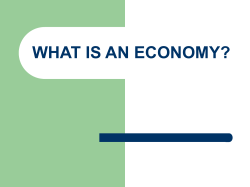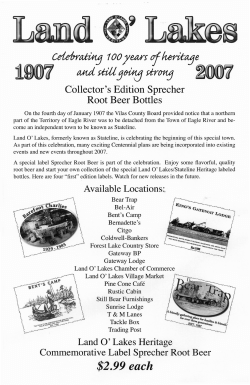
PDF - Great Lakes Virtual Water Accounting
Introducing VIRTUAL WATER ACCOUNTING to the Great Lakes The 21st Century Water Management Problem M ost of us have traditionally assumed that water is an “abundant” public good that is freely available to all people living and working around rivers, lakes and streams. “Scarcity” is the absence of abundance, and signals that there are difficult choices, and tradeoffs that must be made between economic, social, and environmental uses for costly and limited water resources1. Even in the water-rich Great Lakes region of North America, we are beginning to experience scarcity in some of our streams and wetlands. This scarcity is first manifest when it creates socio-environmental damages during the warm summertime lowstreamflow season2. In this season, fish and aquatic ecosystems may be placed under stress if too much water is removed for economic uses. 1 Water follows a complex and mostly hidden path through society. We use water to produce things that we need and value, like food, cars and electricity. Centuries ago, when most of our goods and services were produced locally, the connections between water use, ecosystems and our economy were more easily seen and managed for the common good. In the 21st century, however, globalization has created a world that is highly connected, in which the economic demands of people in distant cities and continents can create intense economic pressure on our water resources through trade. The people of the Great Lakes also choose to outsource their water uses through trade, such as when they buy vegetables grown during the winter in California. As global economic development and trade, drought and climate change increase water scar- city around the world, these invisible connections to Great Lakes water will become ever more powerful. In this connected world we make decisions about what to buy and sell, but it is difficult to see the impacts of our decisions on our water and environment. When water is scarce, are we using our water in the wisest ways, and are we getting the most benefit out of it? Do we agree with how water is being used, when we consider the environmental impacts and economic benefits? How does our choice to pursue some business opportunities, and not others, affect our economy and our water resources? How do we steward our rich water resources to sustainably benefit an increasingly water-scarce world, and ourselves? How do we make sense of these questions in a highly connected world? Zetland, D., 2011. The End of Abundance, Aguanomics Press. Zorn, T. G., P. W. Seelbach, E. S. Rutherford, T. C. Wills, S.-T. Cheng, and M. J. Wiley. 2008. A regional-scale habitat suitability model to assess the effects of flow reduction on fish assemblages in Michigan streams. Michigan Department of Natural Resources, Fisheries Research Report 2089, Ann Arbor. 2 Unveiling the Movement of Water Through Society – the Virtual Water Accounting Solution W e need to visualize and account for the social, environmental and economic effects of these connections on water resources near and far. Virtual Water Accounting provides a solution. Goods and services contain “Virtual Water”3,4 (VW) in proportion to the impact that their production made on the streams and wetlands in the home watershed. When virtual water is exported across a watershed boundary as we sell corn or cars, or when we bring tourists to enjoy our lakes and rivers, we have chosen to use our water resources to benefit our trading partners in distant locations, in exchange for money (Figure 1). The opposite is also true; when we import virtual water as we buy electronics or tomatoes, we avoid using our water resources and creating environmental impacts, but this costs us money. Virtual water export has economic benefits, but its social and environmental costs depend on exactly how, when, and where we use the water. Virtual water imports may offset and reduce those costs by avoiding water use. Figure 1: Virtual water can be exported from a watershed through water embedded in, for example, agricultural or manufactured goods, produced in and exported out of the watershed. Virtual water can also be imported through goods produced in another watershed where water was consumed in the production of those imported goods. It takes a great deal of data to visualize these virtual water connections and their effects on our economy and water resources. Because water impact “hotspots” occur in very specific places and times, the accounting requires detailed data for economic production and trade, along with water use, ecosystems, and stream flows. Bringing Virtual Water Accounting to the Great Lakes – the Kalamazoo Case Study and the Whole Basin A s a Great Lakes case study, the Virtual Water Accounting framework was applied to the Kalamazoo River watershed, located in southwest Michigan. Economic data were coupled to water consumption data for the counties overlapping the watershed. Figure 2 illustrates the consumptive water use and value intensity (an estimated value of water use) for each water use category, aggregated over the counties. The largest consumptive water users are the commercial and thermoelectric sectors. However, the value intensities indicate that industrial sector produces the largest economic Figure 2: Consumptive water use and average value intensities ($/cubic meter) by category for the 10 counties. 3 Allan, T. (1993), Fortunately there are substitutes for water: Otherwise our hydropolitical futures would be impossible, paper presented at Conference on Priorities for Water Resources Allocation and Management, Overseas Dev. Admin., London. 4 Hoekstra, A. Y., A. K. Chapagain, M. M. Aldaya, and M. M. Mekonnen (2011), The Water Footprint Assessment Manual: Setting the Global Standard. Earthscan Publishing. Water Footprint Network. output per volume of water consumed. While value intensity is only one metric for determining the value of water use, it shows that, in this case, the agricultural and thermoelectric sectors apparently bring only small economic returns. This is important when local or regional governments are assessing potential new water users and are concerned about allocating scarce water resources most efficiently. Since the county boundaries do not coincide with the watershed boundaries, the water-using economic activities at the county level were conformed to watershed boundaries through land use-water use relationships5. Figures 3a, b and c show the imports, exports and net virtual water flows in the watershed, total and by county. The greatest virtual exports are in Allegan and Kalamazoo counties, driven by agricultural and urban water use, respectively. These areas also correspond roughly to the areas with highest water scarcity and are indicated with the darkest colors in Figure 3d. However, the virtual water imports to these areas are also relatively high and thus virtually “offset” the ecological water scarcity. In other words, if the areas with heavy virtual water exports and ecologically water scarcity also had to produce the water-consuming goods and services that are currently imported from outside the watershed, the ecologically scarcity would be far more acute. goods and services that are imported into the counties, as opposed to consuming those goods and services generated within the county. To compare virtual water flows against water availability over the Great Lakes, annual water availability was estimated through a simple water balance: mean annual precipitation minus mean annual evapotranspiration7. Figures 4b and 4c show virtual water exports and net virtual water flows relative to annual water availability. The results in Figure 4b for annual virtual water exports relative to annual water availability show that in a few counties, exports constitute more than 5 percent of the average annual water availability, but most are below 1 percent. While these numbers seem Figure 3: Kalamazoo River watershed (a) imports, (b) exports, (c) total net annual virtual water flows by county (normalized by area), and (d) ecological scarcity (D/T) for low flow months. Preliminary results were generated for the U.S. portion of the Great Lakes basin. Figure 4a shows net virtual flows by county, indicating that all but one county is a net virtual water importer 6. This result, as was described earlier for the Kalamazoo River watershed, is primarily due to populations consuming relatively high amounts of water-intensive 5 For example, the fraction of irrigated agricultural land in the portion of a county inside the watershed was used to scale the agricultural water use for that county. 6 Illinois counties (Cook and Lake) were excluded because of the complexity of tracking water withdrawals and eventual delivery of water in the area. The figure indicates that all counties are net importers. Precipitation and evapotranspiration were mapped using long-term estimates of these quantities from the PRISM (http://www.prism.oregonstate.edu/) and USGS (http://onlinelibrary.wiley.com/doi/10.1111/jawr.12010/abstract) databases for the US, respectively. 7 A B Annual net virtual flows by county (Mm3/yr) low, the ratio of exports to water availability could be much higher during low flow months. The results in Figure 4c show that, like the Kalamazoo River example, the virtual water imports offset the exports so that the net virtual water flows do not contribute to reductions of water Ratio of virtual water exports to water availability availability, except for one county. Taken as a whole, the Great Lakes counties are not water scarce and are net water importers. Commercial and industrial sectors produce the greatest return, measured as economic value generated per volume of water consumed. C Ratio of net virtual water to water availability Figure 4: (a) Annual net virtual flows, (b) ratio of annual virtual water exports to annual water availability, and (c) ratio of net annual virtual water flows to annual water availability by county for the U.S. portion of the Great Lakes basin. Inspiring a New Vision for Water Management V irtual Water Accounting adds a new dimension to water management. It helps paint the big picture of how water moves across the landscape in the Great Lakes region and through economy, and therefore, it can inform economic development and water use policy decisions. It provides a means for benchmarking water sustainability by calculating value intensities and water scarcity footprints that show hotspots where scarcity has been caused by water use. It can be used to educate waters users and the general public on the value of water. With Virtual Water Accounting, tough questions can be tackled: Can the Great Lakes region afford to accommodate water uses that yield lower economic value? Can the Great Lakes region afford to shift from being a new water importer to being a net water exporter, without ecological impacts? As a tool, Virtual Water Accounting can be used by both industry and local governments to plan for the future. For Industries, it can enhance water footprinting and sustainability analyses. Local communities can see how water abundance or scarcity may impact growth management scenarios. For more information, contact: Alex Mayer Benjamin L. Ruddell Stanley T. Mubako Michigan Tech Center for Water and Society Michigan Technological University asmayer@mtu.edu Fulton Schools of Engineering Senior Sustainability Scientist, Global Insitute of Sustainability Arizona State University bruddell@asu.edu Center for Environmental Resource Management University of Texas at El Paso stmubako@utep.edu Visit the project website at: www.glvirtualwater.net
© Copyright 2025










